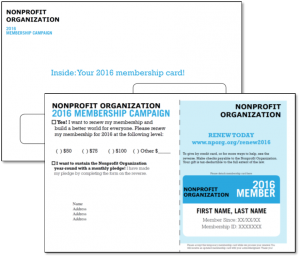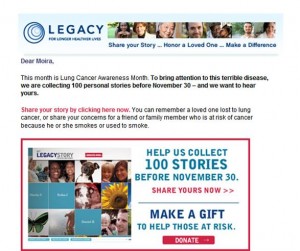Direct response fundraising tends to be consumed in first impressions, rather than in-depth reading of your content. Most of your readers are scanning your work, and not really following the arc of your beautifully created narrative from message to message.
Because of this, being repetitive works.
Rather than scrupulously picking up where you left off Oliver Twist-style after your last fundraising communication, often saying what you just said again works best.
Among the best places to put this strategy to work is in your membership renewal series. In a membership renewal campaign (email or direct mail), you begin by sending a notice to your supporters letting them know that it’s time to renew their membership and sharing all the wonderful things that their membership makes possible.
Some of your supporters will respond and some won’t. Those who don’t respond to this first notice within the response window you set (around 3-4 weeks in direct mail and a matter of days in email), will receive a reminder message from you. And those who still don’t respond will continue to receive reminders as needed over 3 to 10 or more subsequent communications of varied approaches with increasing intensity
Even though membership renewal campaigns are serial in this way, that doesn’t mean each notice needs to be different though. In fact, if one notice in your series is uniquely strong, don’t be afraid to send it again.
For example, many organizations include a membership card in their first direct mail membership renewal notice because it makes sense as the starting place for the renewal dialogue. This technique, which looks a little something like this, also usually produces a very strong response:

Unfortunately, you can’t expect your next renewal notice to non-responders to hit it out of the park in quite the same way. But chances are if you repeat the strategies that worked exceptionally well in the preceding package—in this case the membership card—you’ll achieve better results than you would with a general reminder notice (up to 10% more revenue in testing we’ve done at MKDM).
Here’s what “if it works, do it again” looks like in this scenario:

The same idea holds true in email, perhaps even more so. If you find one particular email in a series surprises you with exceptionally strong results, drop whatever you had planned next and resend it.
Bottom line: be on the lookout for the real stars of your direct mail and email campaigns. If a first act brings the house down, make it the second act too, and maybe even the third.








 There are many important online resources for membership development, but probably only just a few that we feel we couldn’t do without. Today, I’m highlighting some of the essential blogs, Twitter feeds, and resources that I look to for top-notch information, insight and inspiration on donor action and philanthropy:
There are many important online resources for membership development, but probably only just a few that we feel we couldn’t do without. Today, I’m highlighting some of the essential blogs, Twitter feeds, and resources that I look to for top-notch information, insight and inspiration on donor action and philanthropy: on your year end goals and encourage them to participate and spread the word in their own networks. Goals shouldn’t strictly be monetary ones. For instance, in addition to asking for their financial year end support, in November the
on your year end goals and encourage them to participate and spread the word in their own networks. Goals shouldn’t strictly be monetary ones. For instance, in addition to asking for their financial year end support, in November the 



